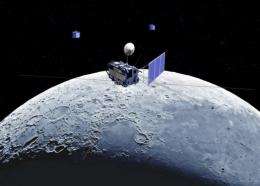Japanese probe yields insights into Moon's inner life

Japanese astronomers on Sunday said they had found traces of a mineral that adds an important piece of knowledge to the puzzle of the Moon's geological past.
Using a instrument-laden probe, Kaguya, which was placed in orbit around the Moon in 2007, the team found abundant signatures of the mineral in concentric rings in three big crater regions.
The mineral, called olivine, is deemed to be a telltale of mantle, the deep inner layer of iron- and magnesium-rich rock that lies beneath the Moon's crust.
A leading theory is that the Moon was created about 4.5 billion years ago after the "Big Whack" -- it was ripped from Earth after our planet suffered a gigantic collision from some space object.
As the material coalesced into a ball, its surface gradually cooled, forming a crust made of a light-coloured aluminous mineral, feldspar, which floated in a dense, molten liquid.
Kaguya's data add a chapter to this "lunar magma ocean" hypothesis.
It suggests that after the crust had formed, there was some massive overturn in the fiery liquid beneath. Olivine-rich mantle was brought from deep within the lunar bowels to within the base of the crust.
At the craters sampled by the probe -- the South Pole-Aitken, Imbrium and Moscoviense impact basins -- the Moon's crust is very thin, and the olivine mantle may have been exposed by asteroids that smashed into the lunar surface, the paper suggests.
The Moon's crust is believed to be far thicker than Earth's, averaging around 70 kilometres (45 miles) in depth, although the thickness varies significantly.
The structure and origins of the Moon's mantle have been fiercely debated by astro-geologists.
The famous Moon rocks brought back by the Apollo missions shed no light on the question, as they were all from the lunar crust. As a result, pointers to the existence of the mantle were, for decades, either sketchy or indirect.
The study, published online by the journal Nature Geoscience, is headed by Satoru Yamamoto of the National Institute for Environmental Studies in Tsukuba.
(c) 2010 AFP


















